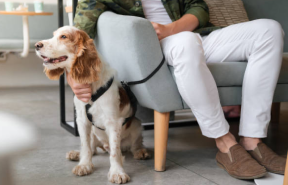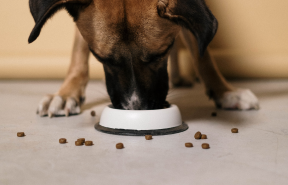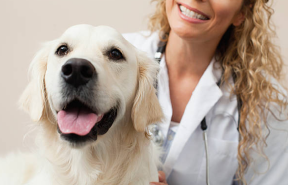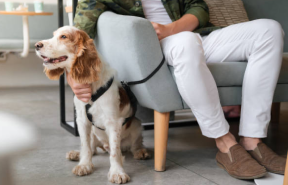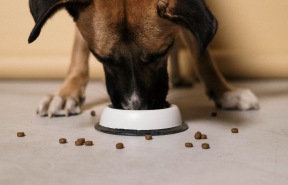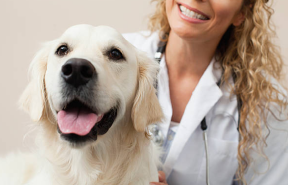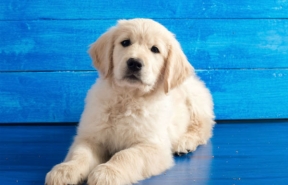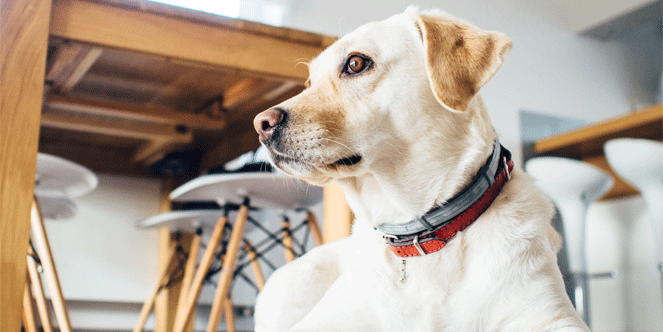Do you have a dog that spooks at his own shadow, hides under the bed when thunder is rumbling overhead or trembles while in the waiting room at the vet? It is a common problem which many dog Owners face, so we asked animal behaviourist, Dr Debbie Calnon, for advice on how manage nervous dogs.
Nervousness can be thought of as a state in which your dog feels a heightened sense of apprehension and uneasiness. There are occasions when dogs require a degree of apprehension to ensure their own well-being. An example would be a dog that chooses to move off a roadway because a car is approaching. However, nervousness can be debilitating if it is experienced in contexts that would not generally elicit a nervous response or that trigger nervousness to an abnormal degree.
What are the Signs of Heightened Nervousness?
Dogs that are nervous have certain physiological reactions that will cause changes in their appearance and behaviour. There are breed and individual differences in how these are expressed. Some of the more common signs that a nervous dog might display are:
- Dilated pupils (the eyes can appear very dark)
- Increased respiration (panting)
- Increased heart rate (you might be able to feel the heart pounding in the chest)
- Muscle rigidity or trembling
- Hyper-vigilance (scanning the environment for potential problems)
- Increased startle response (jumping out of his skin at minor stimuli eg a quiet hand clap)
- Tail tucked under
- Rolling onto the back to expose the belly
- Urination
- Loss of appetite
- Vomiting or diarrhoea
- Excess salivation (dribbling)
- Hackles raised
- Agitation or hyperactivity
- Displacement behaviours such as yawning or sniffing
- Lack of response to owner direction
- Hiding or choosing to withdraw
- Repetitive behaviours such as circling, pacing or tail chasing
- Aggression
It is important to recognise that some of these signs can be expressed when your dog is not nervous. For instance, your dog's pupils will dilate if he enters a dark room or he may vomit because he has eaten your mobile phone (now you're nervous!).
Why are Some Dogs More Nervous than Others?
Genes, the environment and learning all play a role in how nervous a particular dog becomes. Dogs can be specifically bred to exhibit nervous behaviour - extreme fear responses are seen in "nervous" dogs who have been experimentally bred to maintain profound avoidance of humans. This helps to illustrate the important role of breeders in selecting non-nervous individuals to breed with.
The early socialisation and life experiences of puppies also play a vital role. The brain has a period of plasticity at this age that will never be repeated. Providing the pup with positive experiences to a wide range of stimuli and varying environments will give you the best chance of her growing into a confident, relaxed individual.
A small amount of experience prior to 16 weeks of age can have a large influence on future behaviour. Learning continues throughout adulthood. Continuing to manage and train your dog appropriately can still provide significant benefits. Your aim should be to produce the best dog you can, given her genetic predispositions.
Agility and Obedience - the Good News for Frightened Fido
Nervous dogs will have a better quality of life if they have a strong bond with someone who provides a stable and secure environment for them. If a dog has an owner who they recognise as reliable, dependable and in control, then this can provide real benefits in how well the dog learns to cope with elements that it initially perceives as threatening. Good obedience and agility classes can provide the opportunity to build this type of relationship.
You might like to think of a situation that you would find threatening and consider how your ability to cope can be influenced by others. I've never been parachuting but can imagine just how much my heart would be pounding and my legs trembling while I waited to make that jump out of the plane. I know I'd be much more likely to make that leap if I had someone with me who was confident, calm, experienced, offering clear directions and encouraging me forward. The contrasting image of being yelled at and booted out of the plane by someone I had very little trust in compares to different styles of dog training. Obviously the latter scenario is likely to mean I'd never want to be in that situation again. Training methods that set the dog up to succeed and be rewarded for good behaviour will help them to "leap" at the chance to face those big challenges in life, time after time.
There is growing evidence that sustained, regular aerobic activity is beneficial for anxious dogs. It is a fact that certain neurochemicals in the brain are altered with this type of exercise. These changes can enhance the dog's ability to cope with stress. Agility is a great opportunity for you and your dog to have fun together. You work as a team on a physically and mentally challenging activity, which can only serve to improve your relationship.
Agility and Obedience - the Challenges for Frightened Fido
Training methods that foster mutual respect and work to building the dog's confidence are particularly important for nervous dogs. A more fragile temperament means that successful training relies heavily on an owner who can understand their dog's perception of the world. Watching for the signs of nervousness listed above is an integral part of successfully training a nervous dog. It is important to understand that it is your dog's reaction to a particular stimulus, not your reaction, which impacts on his ability to learn.
Good trainers recognise that a stimulus that might be innocuous to most dogs can cause a nervous response for others. This could be something as simple as a garbage bin on the edge of the training ground. Most of the dogs in class might be oblivious to it but frightened Fido may find it very threatening. Fido does not have a choice about this emotional response and it will reduce his ability to focus on the training exercises in class.
Managing your nervous companion during class to ensure that he is not unduly stressed is essential if it is to be a positive experience for both of you. Some dogs will find the close proximity of other dogs stressful (especially if there is barking and fast action as in agility), others might find certain pieces of equipment such as tunnels somewhat nerve wracking, certain exercises such as "stand for examination" are stress inducing for some dogs and the list could go on…If a dog is continually forced into situations that create a nervous response, then this nervousness is likely to become worse. It is an unfortunate fact that once a dog is distressed it can then become more distressed, more quickly with repeated or continued exposure. Dogs with special needs will need particular strategies to allow them time to learn to cope. An example would be a dog needing to do some work on the edge of class for a few weeks or to become accustomed to tunnels and so forth away from the noisy training environment.
Recognising the needs of nervous dogs and providing an opportunity for them to be involved in agility or obedience in a manner that they will find rewarding can be challenging.
Some dogs may need to do some work on confidence building before taking part in a class situation. If in doubt about the suitability for your dog, then seek professional advice.
Dr Debbie Calnon, of Behaviour Counselling Service can be contacted via e-mail at: drdebbie@netlink.com.
